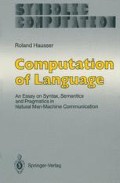Abstract
This chapter describes techniques of linguistic analysis in LA-grammar. The systems discussed are ECAT, an LA-grammar of English, and DCAT, an LA-grammar of German.1 Section 4.1 explains the overall structure of ECAT. Section 4.2 discusses the handling of modifier agreement in English and German. Section 4.3 deals with the phenomenon of valency in English. Section 4.4 explains the handling of word order on the basis of the categorization and the control structure. Section 4.5 discusses the syntactic and semantic nature of pronouns.
Access this chapter
Tax calculation will be finalised at checkout
Purchases are for personal use only
Preview
Unable to display preview. Download preview PDF.
References
For a detailed description of these systems see Hausser (1986). The present versions differ in some details of linguistic description, and in the switch from INTERLISP-D to Common Lisp.
See Householder (1981).
The surname Dyscolus— “the difficult”—can be “explained in three ways, either (a) because the elliptical and compressed nature of his style makes difficult reading, (b) because he was a cantankerous or argumentative person, or (c) because he used to pose rare and difficult words to ancient game-show contestants (who were rival grammarians).” Householder (1981), p. 5.
Op.Cit., Book I, 71.
Householder (1981), p. 9.
Note the specification of category correspondence by explicit definition rather than by the principle of identity (see footnote 4 in Section 2.1). The categorial operations defined by left-associative rules are much more powerful than the cancelling schemas of Categorial Grammar.
(X) and (Y) are variables for sequences. For example, if (X) = (1 2 3), then (a b X c) = (a b 1 2 3 c).
This sentence is a variant of Whom did Eddie try to bite?, which is also accepted by the parser. The version presented in 4.1.4 was chosen as the more interesting one, because it involves the ambiguous sentence start Who(m) did.
“Masterscope” is part of Interlisp-D and displays the structure of programs in terms of function calls. Left-Associative Grammar was initially developed in Interlisp-D on a Xerox 1109. 10 This software was written with the help of Eric Nyberg (Carnegie Mellon University).
The analysis of LA-grammar is relatively high level in that it operates with fully analyzed word forms.
Smolensky (1986).
Because the variables X and Y may be empty, the first and the fourth schema are the most general. Which of the six schemata is used depends on the language and the construction in question.
The category segments GQ, SQ, and PQ stand for “general quantifier”(e.g., the), “singular quantifier” (e.g., every) and “plural quantifier” (e.g., all), respectively. The linguistic interpretation of all ECAT category segments is explained in Appendix A1.
In mass noun constructions, like John drinks red wine, the adjective is treated as a determiner.
Adjectives ending in -EM are disregarded because they incorporate a determiner function.
If we followed a traditional parameter approach, these four distinctions would amount to a total of 48 categories for the four adjective forms of German: two numbers times three genders times four cases times two definiteness distinctions. See Hausser (1986) for a detailed discussion of exhaustive versus distinctive categorization.
Earlier versions of DCAT and ECAT handled agreement of relative clauses by carrying the noun segments along in the category. This resulted in an untidy cluttering of the categories, and was not easily extendable to the handling of conjunction and gapping.
See Chapter 7.
The segments n, d, a, and v represent a nominative, dative, accusative, and verb, respectively. The handling of adverbs is omitted for the sake of simplicity.
I.e., the cat-1 does not contain a ‘v’, which means that the sentence start hasn’t yet incorporated the verb.
See Section 7.3 for further discussion.
See Section 15.2 and 15.5 for the logical definitions in question.
Cf. Section 15.2.
Our notion of “indexical” pronoun use refers to all non-anaphoric uses. Thus it covers what is sometimes called the “deictic” use of pronouns.
These examples are from Lakoff (1968).
Karttunen (1977).
Riemsdijk and Williams (1986, p. 199).
Riemsdijk and Williams (1986, pp. 194, 5).
This aspect is part of the “Predictability Requirement for Pronouns” (Kuno 1972).
Even the use of reflexive pro-forms can be explained in pragmatic terms. The inherently anaphoric use of reflexives is treated simply in terms of inherently anaphoric context variables (Hausser 1979a).
Author information
Authors and Affiliations
Rights and permissions
Copyright information
© 1989 Springer-Verlag Berlin Heidelberg
About this chapter
Cite this chapter
Hausser, R. (1989). Continuations in Natural Language. In: Computation of Language. Symbolic Computation. Springer, Berlin, Heidelberg. https://doi.org/10.1007/978-3-642-74564-5_5
Download citation
DOI: https://doi.org/10.1007/978-3-642-74564-5_5
Publisher Name: Springer, Berlin, Heidelberg
Print ISBN: 978-3-642-74566-9
Online ISBN: 978-3-642-74564-5
eBook Packages: Springer Book Archive

